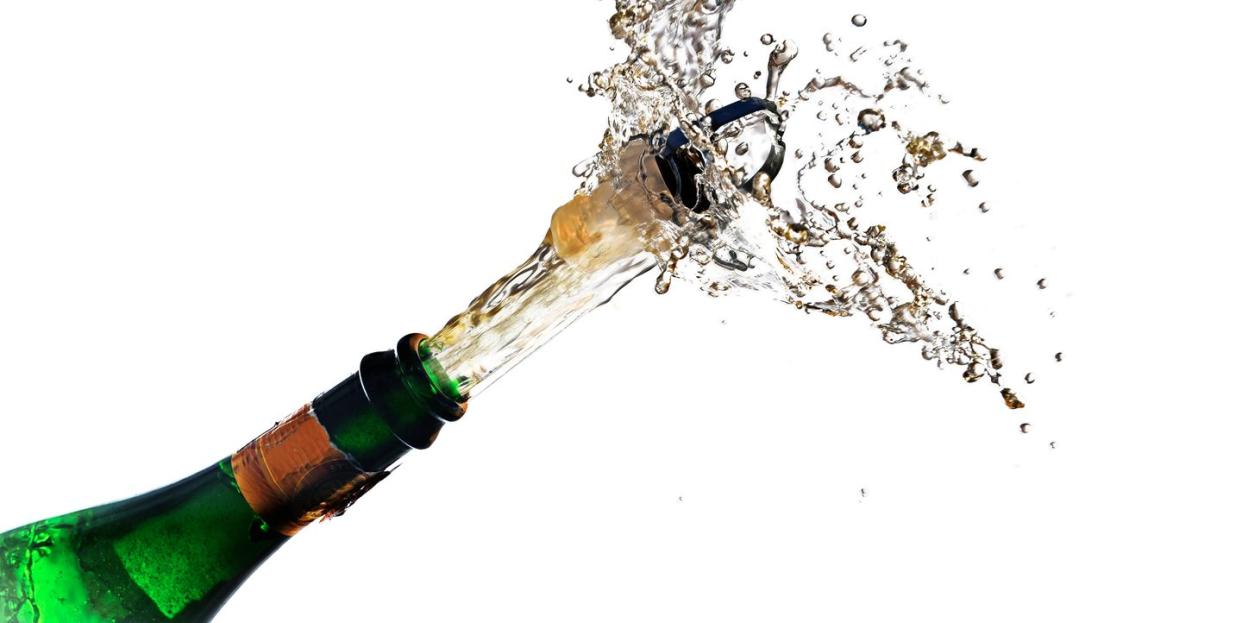How Your Bottle of Champagne Is Basically an F-16

French scientists studied freezing gases expelled from popped champagne bottles and found patterns in the gases that mirrored exhaust from jet and rocket engines.
Freezing carbon dioxide and water vapor gas emitted from these champagne bottles formed a plume of fog called a Mach disk and reached supersonic speeds.
Depending on the temperature at which the bottles were kept, the color of the flume of gas changed.
Pop some champagne! French scientists studying the physics of the effervescent alcohol have found that gases burst out of a popped bottle at speeds similar to those seen in the exhaust of fighter jets. Using high-speed cameras, the team filmed bottles of champagne stored at different temperatures to analyze what would happen as the corks were released.
In the milliseconds after a bottle of bubbly is uncorked, the gases are emitted from the bottle so quickly that they form a freezing shock wave of vapor called a Mach disk—similar to those found in jet and rocket engine exhaust—according to research published today in the journal Science Advances.

“Our goal was to understand what was happening during the strong decompression of gases immediately after” popping the cork, chemical physicist Gérard Liger-Belair of the University of Reims Champagne Ardenne tells Popular Mechanics. “The phenomenological connection with aerospace engineering was quite a surprise.”
Just how fast are these gases released? Liger-Belair says gases propelled from the bottle can reach speeds up to Mach 2—twice the speed of sound. These supersonic gases are propelled by extreme pressure changes within the bottle.
It’s simple physics: During fermentation, dissolved bubbles of carbon dioxide gas form in the liquid. These dissolved gas bubbles are kept in the liquid by pressurized carbon dioxide gas in the neck of the champagne bottle. When the cork pops, all that gas is released.
The amount of pressure inside the bottle depends on the temperature at which the bottle is kept. Liger-Belair and his team found that if a bottle of champagne is stored at 68 degrees Fahrenheit, the pressure within builds to 7.5 bars. If the bottle reaches temperatures of roughly 86 degrees Fahrenheit, the pressure within the bottle can increase to 10.2 bars.
When pressure is released, the temperature of carbon dioxide expelled from the bottle (and nearby water vapor) drops, and the gases condense into a fog. This occurs due to a phenomenon called adiabatic cooling. As the volume of a gas increases, its temperature drops. How far temperatures drop changes the color of this fog.
In the study, freezing gases released from the bottles stored at 68 degrees Fahrenheit dropped to temperatures of nearly -130 degrees Fahrenheit and briefly produced a blue fog. The tiny dry ice particles that formed mostly reflected short wavelengths of blue light. Bottles stored at 86 degrees Fahrenheit released gases so cold (approximately -140 degrees fahrenheit) that they turned nearby water vapor to fog. The particles in this fog were similar to or larger than nearby wavelengths of light, resulting in a white, cloud-like haze.
Liger-Belair says the main challenge was capturing footage of the cork popping. He and his team often use high speed footage to study the physics of everyday objects, and have previously published work looking at the physics of bursting champagne bubbles.
Cheers to cool spirits science.
You Might Also Like
